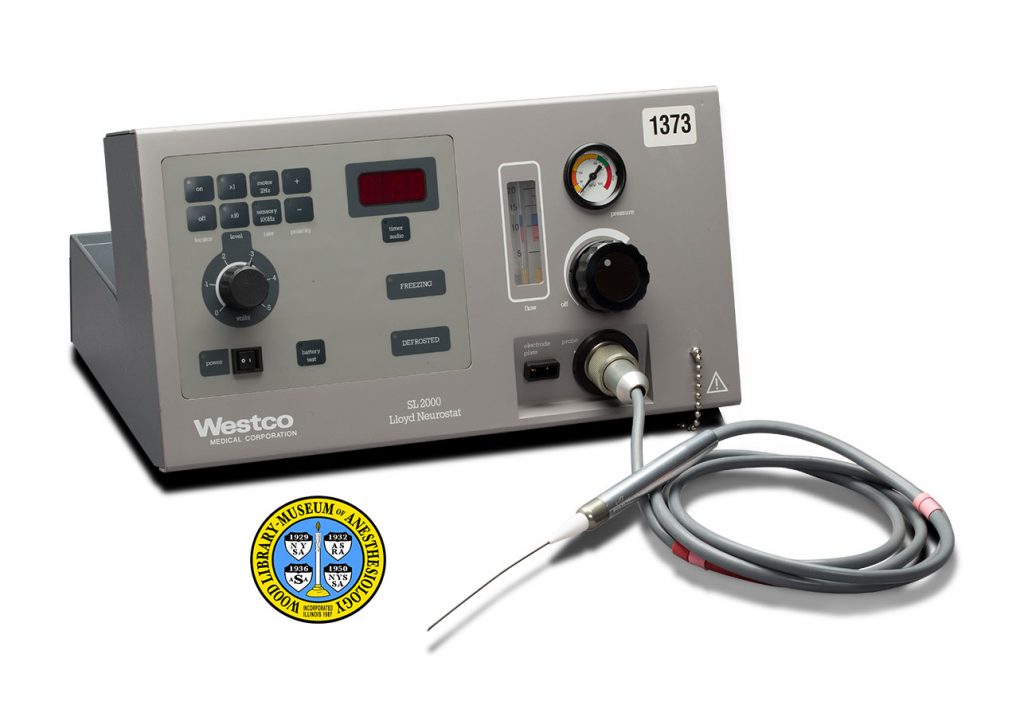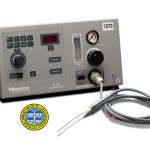Westco Lloyd Neurostat
The word cryoanalgesia combines the Greek words for cold (κρÏο) and the absence of pain (αναλγησία). Cold water and ice have been used to treat pain since the time of the ancient Greek physician Hippocrates. English physician James Arnott (1797-1883) pioneered the use of cold temperatures in surgery and dentistry. In the late 1840s, he recommended cold as an alternative to chloroform. Since the late 19th Century, ethyl chloride, methyl chloride and compressed carbon dioxide gas have been used to "freeze" the skin by their extremely rapid evaporation.
In the 1960s, precision cryosurgical probes were developed for the purpose of destroying diseased tissues. The use of such probes for the treatment of chronic pain began in the 1970s. This coincided with the emergence of the new specialty of pain medicine. British physician John W. Lloyd, M.D. was among the first to research and to advocate cryoanalgesia techniques which provided pain relief that could last for weeks. In 1980, he and his colleagues received a U. S. patent for their cryosurgical probe. Manufactured in England by Spembly Medical, Ltd., the Lloyd Neurostat SL 2000 cryoanalgesia apparatus used a probe to freeze nerves that caused chronic pain.
Catalog Record: Westco Lloyd Neurostat
Neurostat
Access Key: aqlh
Accession No.: 2005-06-08-1
Title: SL 2000 Loyd Neurostat / Westco Medical Corporation.
Corporate Author: Westco Medical Corporation.
Publisher: San Diego, California : Westco Medical Corporation, [between 1980 and 2005].
Physical Description: 1 cryosurgery device : metals, plastics ; 22 x 529 x 339 cm.
Subject: Analgesia.
Subject: Carbon Dioxide.
Subject: Nitrous Oxide.
Note Type: General
Notes: The first year in the range of possible dates of manufacture is based on the date of Dr. Lloyd’s patent. The second year in the date range is the date that the object was acquired
The device is described with the control panel facing forward.
Lloyd’s 1980 patent illustrations suggest that the cataloged object may be missing some parts.
Note Type: General
Notes: A search of scholar.google.com (accessed December 20, 2017) found items mentioning Westco Medical Corp. dating from 1989 to 2016. Of these, articles mentioning Westco cryoanalgesia equipment date from 1993 to 2013; two of these, dated 1998 and 2013, specify the Neurostat Mark 2, and two others, dated 2002 and 2007, specify the Neurostat III cryoneedle.
Unrelated to Westco Medical, Ltd., which did business in Liverpool, England, from 2009 to 2015.
Note Type: Citation
Notes: Arnott J. Practical Illustrations of the Treatment of the Principal Varieties of Headach by the Local Application of Benumbing Cold : with Remarks on the Remedial and Anaesthetic Uses of Congelation in Diseases of the Skin and Surgical Operations. London : J. Churchill ; Brighton : Henry S. King, 1849.
Note Type: Citation
Notes: Arnott J. Comparison Between Chloroform and Cold as Anaesthetics. [Philadelphia : Blanchard & Lea], 1854.
Note Type: Citation
Notes: Arnott J. On the Effect of Chloroform on the Result of Surgical Operations. London: J. Churchill, 1856. https://www.woodlibrarymuseum.org/rarebooks/item/877/arnott-j.-on-the-effect-of-chloroform-upon-the-result-of-surgical-operations,-1856. Accessed November 8, 2017.
Note Type: Citation
Notes: Barnard D. The effects of extreme cold on sensory nerves. Ann R Coll Surg Engl. May 1980;62(3):180-187.
Note Type: Citation
Notes: Bizpedia website. https://www.bizapedia.com/ca/westco-medical-inc.html. Accessed December 20, 2017.
Note Type: Citation
Notes: James Arnott (physician). https://en.wikipedia.org/wiki/James_Arnott_(physician). Accessed November 21, 2017.
Note Type: Citation
Notes: Lloyd JW. Use of analgesia: the anaesthetist and the pain clinic. B Med J. August 9, 1980;281(6237):432-434.
Note Type: Citation
Notes: Lloyd JW, Wild DE, Evatt HR, inventors. Cryosurgical probe. US patent 4,207,897. June 17, 1980.
Note Type: Citation
Notes: Xu K, Korpan NN, Niu L, eds. Modern Cryosurgery for Cancer. Singapore: World Scientific Publishing Co., 2012:3-27.
Note Type: Physical Description
Notes: One cryosurgical device ; The dimensions in the short description gives the maximum possible width and depth; The gas exhaust line and foot pedal extend to the left and right of the device, respectfully; The gas line extends from the back of the device and the probe extends from the front of the device; The length of the gas exhaust line alone is 305 cm, foot pedal is 224 cm, gas line is 107 cm, and probe is 216 cm; The device without any lines has a width of 40 cm and depth of 26 cm; The length of the handheld portion of the probe is 28 cm;
One cryosurgical device; Consists of a battery-operated tabletop console with lines for cryoprobe, foot pedal, gas supply with N2O yoke, and gas exhaust;
The console has a metal and plastic casing; Plastic insulated lines for the foot pedal, gas supply, and gas exhaust run from the back of the console next to the battery compartment; The battery compartment is accessible by two locking screws on either side of the compartment; The battery tray pulls out and holds six 1.5 Volt size ‘D’ batteries; The cryoprobe line has a brass fitting that connects to the front of the console; The front of the console has all controls, gauges, and displays;
Controls and displays on the console: On/off rocker switch; membrane buttons; Red LED timer display; Pressure gauge and dial; flow meter; port for ‘Electrode Plate’; port for cryoprobe; Sticker on upper right side of front panel reads: 1373; Printed on back of console: ‘Basic Operating Instructions’ and ‘Safety Precautions’; Serial No. [new line] 02984; Mod. State [new line] 7; Made in England by [new line] Spembly Medical LTD; Cryoprobe reads: LLOYD PROBE 44/0174 [new line] EX-9;
Note Type: Reproduction
Notes: Photographed by Mr. Steve Donisch, June 19, 2017.
Note Type: Acquisition
Notes: Purchase.
Note Type: Historical
Notes: The word cryoanalgesia combines the Greek words for cold (κρÏο) and the absence of pain (αναλγησία). Cold water and ice have been to treat pain has been known since the time of the ancient Greek physician Hippocrates (ca. 460-375 bce). English physician James Arnott (1797-1883) pioneered the use of cold temperatures in surgery and dentistry. In the late 1840s, he recommended ice as an alternative to chloroform. Since the late 19th Century, ethyl chloride, methyl chloride and compressed carbon dioxide gas have been used to “freeze” the skin by their extremely rapid evaporation.
In the 1960s, precision cryosurgical probes were developed for the purpose of destroying diseased tissues. The use of such probes for the treatment of chronic pain began in the 1970s. This coincided with the emergence of the new specialty of pain medicine. British physician John W. Lloyd, M.D. was among the first to research and to advocate cryoanalgesia techniques which provided pain relief that could last for weeks. In 1980, he and his colleagues received a U. S. patent for their cryosurgical probe.
The Lloyd Neurostat SL 2000 cryoanlagesia apparatus was manufactured in Andover, Hampshire, England by Spembly Medical, Ltd. for Westco Medical Corporation. Westco was incorporated in San Diego California in 1977. The apparatus used a probe to freeze nerves that caused chronic pain. The probe could deliver either nitrous oxide or carbon dioxide.
Note Type: Exhibition
Notes: Selected for the WLM website.


